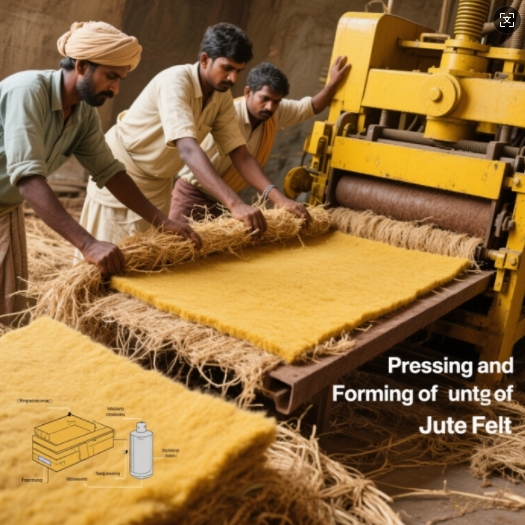Jute, often called the “golden fiber,” is a 100% biodegradable and renewable material prized for its strength, versatility, and low environmental impact. As a leading jute felt manufacturer, NW Fabric Company rely on this natural fiber to create durable, eco-conscious products. But how exactly does raw jute become the soft, resilient felt used in carpets, insulation, and crafts? Let’s explore the jute manufacturing process in detail.

Step 1: Raw Jute Bale Selection & Preparation
The journey begins with raw jute bales sourced from sustainable farms. At this stage:
- Quality Check: Fibers are inspected for color, length, and freedom from contaminants (e.g., dust, woody particles).
- Softening: Fibers are treated with an emulsion of water and natural oils (e.g., coconut or mineral oil) to reduce brittleness and improve flexibility. This step ensures smoother processing in later stages.
Why It Matters: Proper softening minimizes fiber breakage, directly impacting the consistency of your jute felt’s texture.
Step 2: Fiber Piling, Breaking, & Carding
Next, fibers undergo mechanical processing to align and refine them:
- Piling: Softened jute is stacked for 24–48 hours to allow even oil penetration.
- Breaking: Machines with toothed rollers separate tangled fibers and remove short strands.
- Carding: Fibers pass through a carding machine, where rotating drums with fine needles convert them into uniform jute slivers (continuous, untwisted strands).
Key Insight: Carding determines the sliver’s thickness, which influences the final felt’s density and strength.
Step 3: Drawing & Spinning into Yarn
To transform slivers into yarn:
- Drawing: Slivers are stretched and blended through multiple drafting stages, ensuring uniformity.
- Spinning: Using ring spinning or open-end spinning machines, fibers are twisted into jute yarn. Thicker yarns are used for heavy-duty products like burlap, while finer yarns suit premium felt.
Pro Tip: The yarn’s twist level affects felt durability—higher twist yields stronger fabrics.
Step 4: Winding & Beaming for Weaving
Before weaving, yarns are prepared for efficient handling:
- Winding: Yarn is wound onto bobbins or cones to prevent tangling.
- Beaming: Hundreds of warp yarns (lengthwise threads) are aligned on a beam under controlled tension, ready for the loom.
Step 5: Weaving Jute Fabric
On industrial looms, warp and weft yarns are interlaced to produce:
- Hessian (Burlap): Lightweight, open-weave fabric for bags or decor.
- Sacking Cloth: Dense, sturdy material for packaging.
- Felt Base Fabric: Tightly woven fabric that forms the foundation for needle-punched jute felt.
Modern vs. Traditional: While shuttleless looms (e.g., rapier or air-jet) dominate today, some artisans still use handlooms for specialty products.
Step 6: Finishing Processes for Jute Felt
The woven fabric becomes felt through critical finishing steps:
- Needle Punching: Barbed needles entangle fibers, creating a non-woven, dense felt structure.
- Damping: Moisture is applied to stabilize the fabric and reduce shrinkage.
- Calendering: Heated rollers compress the felt, enhancing smoothness and thickness consistency.
- Cutting & Hemming: Felt sheets are trimmed to size, with edges sealed to prevent fraying.
Customization Options:
- Add fire resistance or water repellency with eco-friendly coatings.
- Dye fibers naturally for colorful felt without synthetic chemicals.
Why Choose Jute Felt? Sustainability Meets Functionality
Jute felt stands out as a planet-friendly alternative to synthetic materials. Here’s why:
- Carbon Negative: Jute plants absorb more CO2 than most crops.
- Biodegradable: Breaks down naturally, unlike plastic-based felts.
- Versatile: Ideal for insulation, acoustic panels, rugs, and DIY crafts.
According to a 2024 Textile Exchange report, demand for jute products has grown by 18% annually as industries prioritize sustainability.
Partner with a Trusted Jute Felt Manufacturer
At NW Fabric, we combine centuries-old jute craftsmanship with cutting-edge technology to deliver high-performance felt. Our process adheres to:
- Zero-Waste Practices: Byproducts like short fibers are recycled into paper or compost.
- Ethical Sourcing: We work directly with Fair Trade-certified jute farms.
Whether you need custom jute felt for industrial or creative applications, we ensure quality at every step.
